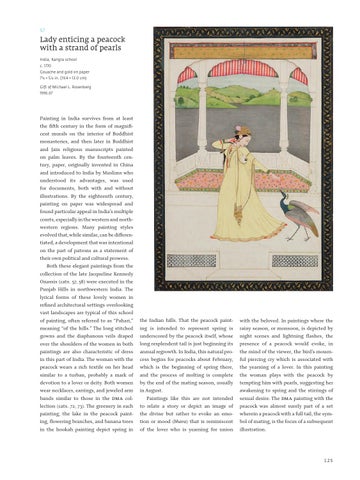57
Lady enticing a peacock with a strand of pearls India, Kangra school c. 1770 Gouache and gold on paper 7 5/* × 5 1/* in. (19.4 × 13.0 cm) Gift of Michael L. Rosenberg 1996.67
Painting in India survives from at least the fifth century in the form of magnificent murals on the interior of Buddhist monasteries, and then later in Buddhist and Jain religious manuscripts painted on palm leaves. By the fourteenth century, paper, originally invented in China and introduced to India by Muslims who understood its advantages, was used for documents, both with and without illustrations. By the eighteenth century, painting on paper was widespread and found particular appeal in India’s multiple courts, especially in the western and northwestern regions. Many painting styles evolved that, while similar, can be differentiated, a development that was intentional on the part of patrons as a statement of their own political and cultural prowess. Both these elegant paintings from the collection of the late Jacqueline Kennedy Onassis (cats. 57, 58) were executed in the Punjab Hills in northwestern India. The lyrical forms of these lovely women in refined architectural settings overlooking vast landscapes are typical of this school of painting, often referred to as “Pahari,” meaning “of the hills.” The long stitched gowns and the diaphanous veils draped over the shoulders of the women in both paintings are also characteristic of dress in this part of India. The woman with the peacock wears a rich textile on her head similar to a turban, probably a mark of devotion to a lover or deity. Both women wear necklaces, earrings, and jeweled arm bands similar to those in the DMA collection (cats. 72, 73). The greenery in each painting, the lake in the peacock painting, flowering branches, and banana trees in the hookah painting depict spring in
the Indian hills. That the peacock painting is intended to represent spring is underscored by the peacock itself, whose long resplendent tail is just beginning its annual regrowth. In India, this natural process begins for peacocks about February, which is the beginning of spring there, and the process of molting is complete by the end of the mating season, usually in August. Paintings like this are not intended to relate a story or depict an image of the divine but rather to evoke an emotion or mood (bhava) that is reminiscent of the lover who is yearning for union
with the beloved. In paintings where the rainy season, or monsoon, is depicted by night scenes and lightning flashes, the presence of a peacock would evoke, in the mind of the viewer, the bird’s mournful piercing cry which is associated with the yearning of a lover. In this painting the woman plays with the peacock by tempting him with pearls, suggesting her awakening to spring and the stirrings of sexual desire. The DMA painting with the peacock was almost surely part of a set wherein a peacock with a full tail, the symbol of mating, is the focus of a subsequent illustration.
125
